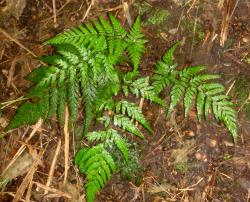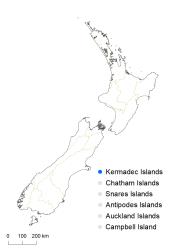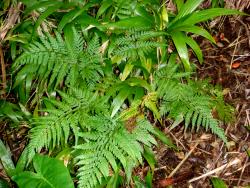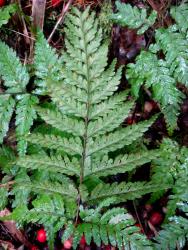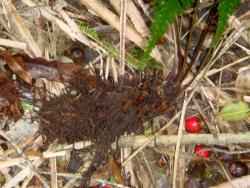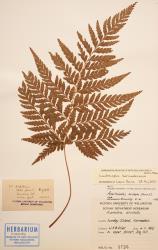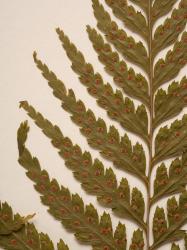- ≡ Lastreopsis kermadecensis Perrie & Brownsey, New Zealand J. Bot. 50: 33 (2012)
Rhizomes erect or prostrate, up to 140 mm long (in herbarium material), with fronds clustered at the apex, densely scaly. Rhizome scales linear to narrowly ovate, 7–8 mm long, c. 1 mm wide, brown, margins entire or ciliate. Fronds 370–910 mm long. Stipes 100–500 mm long, red-brown proximally, yellow-brown distally, scaly proximally, hairy or glabrous; scales narrowly ovate, brown or dark brown, 5–12 mm long, 0.8–2.1 mm wide, apices acuminate, margins entire or ciliate; hairs red-brown, catenate (ctenitoid), up to 0.7 mm long. Rachises yellow-brown, sulcate, narrowly winged only at distal end, the sulcus abundantly filled with reddish catenate hairs up to 0.2 mm long, with slightly longer reddish hairs up to 0.3 mm long at costa/rachis junctions. Laminae 2-pinnate-pinnatifid to 3-pinnate, ovate, 145–450 mm long, 100–330 mm wide, pale green on both surfaces, herbaceous, glabrous or with scattered hairs abaxially, reddish catenate hairs up to 0.3 mm long on adaxial costae, and tiny yellow or orange clavate glands on abaxial lamina surfaces. Primary pinnae in 8–16 pairs below pinnatifid apex, slightly overlapping; distal pinnae narrowly ovate, proximal pinnae ovate or broadly ovate; the longest at or near the base, 75–250 mm long, 50–210 mm wide, apices acuminate, bases stalked; costae narrowly winged for most of their length except on largest fronds. Acroscopic secondary pinnae decreasing evenly in length along the primary pinnae to the distal end; the basal basiscopic 1–2 pairs of secondary pinnae longer than the others, narrowly ovate, 35–150 mm long, 11–45 mm wide, apices acute or acuminate, bases stalked, costae winged throughout. Tertiary segments oblong, 11–23 mm long, 2–8 mm wide, apices acute or obtuse with several teeth, margins serrate, bases adnate or stalked. Sori round, medial; indusia reniform, 0.7–1.3 mm diameter, concolorous, yellow glands present or absent on the margins and surface.
Parapolystichum kermadecense is endemic to the Kermadec Islands, and the only species of Parapolystichum or Lastreopsis found there. It is distinguished by its erect to prostrate rhizome, 2-pinnate-pinnatifid to 3‑pinnate laminae, reddish catenate hairs largely confined to the sulcus and adaxial costae, and only scattered hairs present on the abaxial surfaces. Within New Zealand it is most similar to Parapolystichum glabellum, which generally has a more divided frond, narrower secondary pinnae (10–90 cf. 35–150 mm long, 3–35 cf. 11–45 mm wide), longer and more abundant hairs, and more frequent and conspicuous glands.
Kermadec Islands.
Altitudinal range: 130–520 m.
Parapolystichum kermadecense is endemic to Raoul Island in the Kermadec Islands.
Parapolystichum kermadecense is a terrestrial fern found in the wet forest of Raoul Island, where it occurs above c. 125 m, particularly under Rhopalostylis baueri and Metrosideros kermadecensis.
Parapolystichum kermadecense was given a conservation status of Naturally Uncommon by de Lange et al. (2018).
2n = 164 (see Perrie & Brownsey 2012 – as Lastreopsis kermadecensis).



